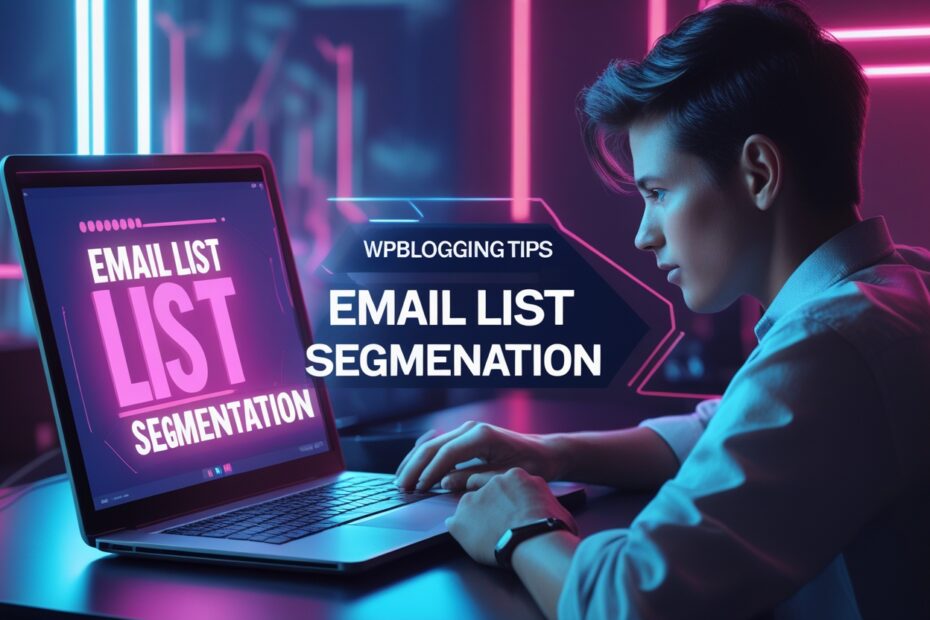Not all email subscribers are the same. Some are new readers, others are loyal fans, and some are interested buyers. Sending the same email to everyone hurts engagement and lowers conversions.
The solution? Email list segmentation.
By dividing your subscribers into targeted groups, you can send personalized emails that increase open rates, clicks, and sales.
In this guide, you’ll learn best practices for email list segmentation and how to implement them effectively.
What is Email List Segmentation?
📌 Email list segmentation is the process of dividing your email subscribers into smaller groups based on demographics, behavior, interests, or engagement levels.
Why does it matter?
✔ Higher open rates – Personalized emails get 26% more opens (Campaign Monitor).
✔ More engagement – Segmented emails get 100.95% more clicks than non-segmented ones (Mailchimp).
✔ Better conversions – Sending relevant content boosts purchases and actions.
👉 Related Article: How to Increase Email Open Rates
1. Types of Email List Segmentation
Here are six powerful ways to segment your email list for maximum engagement:
A. Demographic Segmentation
🔹 Age, gender, location, job title, income level
📌 Example:
- A fitness blog can send weight loss tips to younger subscribers and joint health tips to older ones.
- An eCommerce site can promote winter clothing to subscribers in cold regions and summer apparel to those in warmer areas.
💡 Pro Tip: Collect demographic data using signup forms and surveys.
B. Behavior-Based Segmentation
🔹 Actions subscribers take on your website or emails
📌 Example:
- If a subscriber clicked on an SEO course link but didn’t buy, send a follow-up email with a discount.
- If a subscriber always reads emails about blogging tips, send them advanced blogging guides.
💡 Pro Tip: Use website tracking tools like Google Analytics and email click tracking in your email platform.
👉 Related Article: How to Create a High-Converting Email Funnel
C. Engagement-Based Segmentation
🔹 Active vs. inactive subscribers
📌 Example:
- If someone hasn’t opened an email in 3 months, send a re-engagement email:
- Subject: “We Miss You! Here’s 20% Off Your Next Course”
- CTA: “Click Here to Reactivate Your Subscription”
💡 Pro Tip: Remove completely inactive subscribers every 6 months to keep your list healthy.
D. Purchase History Segmentation
🔹 Target subscribers based on past purchases
📌 Example:
- If a customer bought a beginner-level SEO guide, send them an email about an advanced SEO course.
- If someone buys a product regularly, offer a subscription or loyalty discount.
💡 Pro Tip: Integrate your email marketing tool with your eCommerce platform (Shopify, WooCommerce, etc.).
E. Source of Subscription Segmentation
🔹 Where subscribers signed up from
📌 Example:
- If a user joined through a blog post about email marketing, send them related email marketing tips.
- If they signed up via a webinar, send follow-up content related to that webinar.
💡 Pro Tip: Use UTM parameters in your sign-up forms to track traffic sources.
F. Lead Magnet-Based Segmentation
🔹 Segment based on what freebie they signed up for
📌 Example:
- If someone downloaded a “Blogging Checklist,” send them more blogging-related content.
- If they got a “Social Media Marketing Ebook,” send them Facebook & Instagram tips.
💡 Pro Tip: Use different lead magnets for different audience segments.
👉 Related Article: How to Build an Email List from Scratch
2. How to Implement Email Segmentation
Step 1: Collect the Right Data
🔹 Ask for relevant info on sign-up forms (e.g., interests, industry).
🔹 Track subscriber activity (email clicks, website visits).
🔹 Use surveys & quizzes to understand preferences.
Step 2: Use an Email Marketing Tool with Segmentation Features
Here are the best email marketing platforms for segmentation:
| Tool | Best For | Free Plan? |
|---|---|---|
| ConvertKit | Bloggers & creators | ✅ Yes (1K subscribers) |
| Mailchimp | Small businesses | ✅ Yes (500 subscribers) |
| Brevo (formerly Sendinblue) | Advanced segmentation | ✅ Yes (daily send limits) |
| GetResponse | eCommerce brands | ❌ No |
🔗 External Resource: Mailchimp’s Guide to Segmentation
Step 3: Create Segmented Email Campaigns
Once your segments are set, create targeted campaigns.
📌 Example Campaigns:
✔ Re-engagement campaign – “We Miss You! Here’s 10% Off”
✔ VIP customer emails – “Exclusive Offer for Our Best Customers”
✔ Location-based emails – “Upcoming Events in Your City”
Step 4: Test & Optimize
📊 Use A/B testing to compare:
✅ Segmented emails vs. non-segmented emails
✅ Different email subject lines for each segment
✅ Personalized CTAs vs. generic CTAs
👉 Related Article: How to Avoid Spam Filters in Email Marketing
3. Common Segmentation Mistakes to Avoid
❌ Over-segmenting – Too many small lists can be hard to manage.
❌ Ignoring list cleaning – Remove inactive users every 6 months.
❌ Sending irrelevant content – Each segment should receive highly targeted emails.
🔗 External Resource: HubSpot’s Email Segmentation Guide
Final Thoughts
Email list segmentation is one of the most powerful ways to improve engagement, increase conversions, and make subscribers feel valued.
💡 Key Takeaways:
✔ Segment your audience based on behavior, engagement, purchases, and preferences.
✔ Use the right email marketing tool to automate segmentation.
✔ Personalized emails = higher open rates & more conversions.
✔ Test and optimize campaigns for best results.
Now, it’s time to segment your email list and send your first targeted campaign! 🚀

